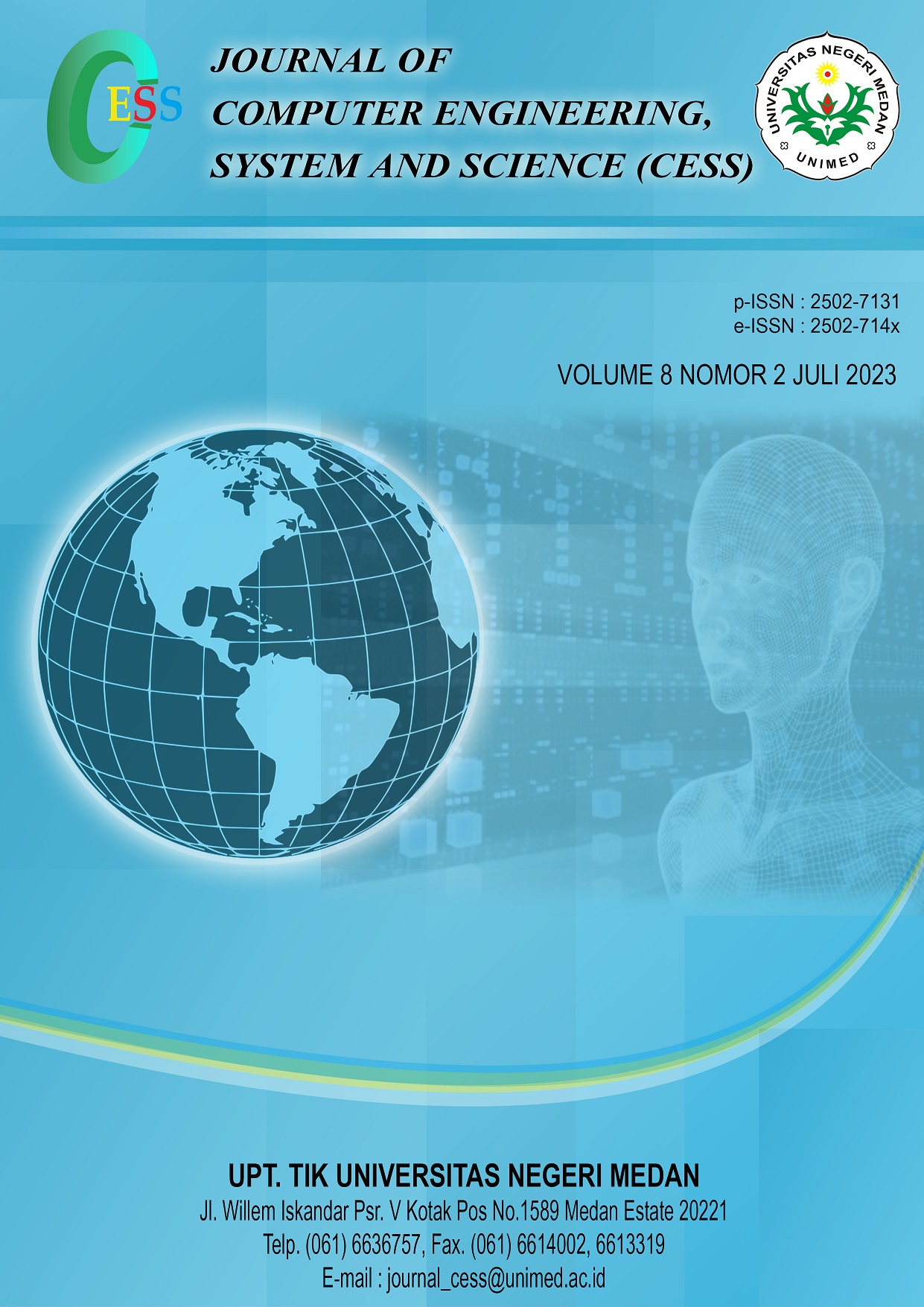Usability of Brain Tumor Detection Using the DNN (Deep Neural Network) Method Based on Medical Image on DICOM
DOI:
https://doi.org/10.24114/cess.v8i2.48727Keywords:
Brain Tumor, CT Scan, Deep Neural NetworkAbstract
Deteksi tumor otak merupakan bidang penelitian yang menarik untuk diteliti. Perkembangan teknologi informasi menghasilkan berbagai metode yang dipergunakan antara lain menggunakan CT (Computed Tomography) scan atau dikenal dengan teknologi CT scan. CT Scan mempunyai berbagai macam keunggulan dalam mendeteksi tumor otak antara lain pada sisi kecepatan, kemampuan memvisualisasikan citra 3 dimensi dan kemampuan membedakan antar jaringan yang berbeda. Keunggulan CT Scan tersebut membuat para peneliti tertarik untuk mengembangkan berbagai jenis metode yang dipergunakan untuk menganalisis dan memprediksikan hasil CT scan tersebut. Salah satu metode yang dipergunakan adalah menggunakan pendekatan Machine Learning (ML). ML dapat digunakan untuk deteksi tumor otak dengan CT scan. Prosesnya melibatkan penggunaan algoritma ML untuk mengidentifikasi pola-pola yang terdapat pada gambar CT scan pasien dengan tumor otak. Dalam hal ini, CT scan pasien dengan tumor otak digunakan sebagai dataset pelatihan untuk membangun model ML. Namun penggunaan Machine Learning juga memiliki keterbatasan dalam hal kurang handal nya Model dan kesulitan hasil deteksi yang diinterpretasikan dokter. Metode ML akan mengalami ketidakakuratan prediksi dengan model training data yang semakin besar sehingga membutuhkan metode lain yang bisa menghasilkan tingkat akurasi yang tinggi. Deep Learning (DL) merupakan fenomena baru pada dunia teknologi informasi dan telah berhasil diimplementasikan pada berbagai macam bidang penelitian. DL memberikan tingkat akurasi yang semakin tinggi jika didukung data yang semakin besar. Penelitian ini mengaplikasikan salah satu metode DL yaitu Deep Neural Network (DNN) untuk memprediksi tumor otak dari hasil CT Scan yang akan disimpan pada cloud server sehingga bisa diakses kapanpun dan dimanapun juga sepanjang tersedia teknologi Internet. Hasil penelitian ini akan bermanfaat bagi para tenaga medis dalam memprediksi tumor otak dengan lebih akurat berdasarkan gambar citra dari CT scan.Detection of brain tumors is an interesting field of research to study. The development of information technology has resulted in various methods being used, including using a CT (Computed Tomography) scan or known as CT Scan technology. CT Scan has various advantages in detecting brain tumors, including in terms of speed, the ability to visualize 3-dimensional images and the ability to distinguish between different tissues. The superiority of the CT Scan makes researchers interested in developing various types of methods used to analyze and predict the results of the CT Scan. One of the methods used is the Machine Learning (ML) approach. ML can be used to detect brain tumors with CT scans. The process involves using ML algorithms to identify patterns present in the CT scan images of patients with brain tumors. In this case, CT scans of patients with brain tumors are used as a training dataset to construct the ML model. However, the use of Machine Learning also has limitations in terms of the lack of reliability of the model and the difficulty of interpreting the results of detection by doctors. The ML method will experience prediction inaccuracies with the larger training data model, requiring other methods that can produce a high level of accuracy. Deep Learning (DL) is a new phenomenon in the world of information technology and has been successfully implemented in various research fields. DL provides a higher level of accuracy if it is supported by larger data. This study applies one of the DL methods, namely Deep Neural Network (DNN) to predict brain tumors from CT Scan results which will be stored on a cloud server so that they can be accessed anytime and anywhere as long as Internet technology is available. The results of this study will be useful for medical personnel in predicting brain tumors more accurately based on images from CT scans.Downloads
References
Sari E, Windarti I, Wahyuni A. Clinical Characteristics and Histopathology of Brain Tumor at Two Hospitals in Bandar Lampung. J Kedokt Univ Lampung. 2014;69:48“56.
Khoirina NI, Kartikasari Y, Sudiyono S. Perbedaan Kualitas Citra Anatomis Pemeriksaan Computed Tomography Angiography (Cta) Aorta Abdominalis Dengan Variasi Nilai Threshold. J Ris Kesehat. 2017;5(2):65.
Sumijan SS, Purnama AW, Arlis S. Peningkatan Kualitas Citra CT-Scan dengan Penggabungan Metode Filter Gaussian dan Filter Median. J Teknol Inf dan Ilmu Komput. 2019;6(6):591.
Rais AN, Riana D. Segmentasi Citra Tumor Otak Menggunakan Support Vector Machine Classifier. Semin Nas Inov dan Tren [Internet]. 2018;1(1):2018. Available from: https://doi.org/10.1109/BMEI.2012.6512995
Marita V, Nurhasanah, Sanubaya I. Identifikasi Tumor Otak Menggunakan Jaringan Syaraf Tiruan Propagasi Balik pada Citra CT-Scan Otak. Prism Fis. 2014;V(3):117“22.
Rohani. Identifikasi Area Tumor Pada Citra Ct Scan Tumor Otak Menggunakan Metode Expectation Maximization Gaussian Mixture Model (EM-GMM) Tugas Akhir Tumor Otak Menggunakan Metode Expectation Maximization Gaussian Mixture Model (EM-GMM). 2013;
Gavrishchaka V V., Yang Z, (Rebecca) Miao X, Senyukova O. Advantages of hybrid deep learning frameworks in applications with limited data. Int J Mach Learn Comput. 2018;8(6):549“58.
Nasution ARS. Identifikasi Permasalahan Penelitian. ALACRITY J Educ. 2021;1(2):13
Edi Winarno,2023, Real Time Detection of Face Mask Using Convolution Neural Network. Vol.7.No 3(2023)697-704
Bahi M, Batouche M. Deep Learning for Ligand-Based Virtual Screening in Drug Discovery. Proc - PAIS 2018 Int Conf Pattern Anal Intell Syst. 2018;(October 2018).
Aziz Fajar, 2020, Reconstructing and Resizing 3D Images from DICOM files.
Haridimous, 2023, Data Infrastructrures fo AI In Medical Imaging
Sarah Madeline,2021, Free Software for Annotating DICOM In Deep Learning
Branimir, 2023, MIDOM A DICOM Based Medical Image Communication System
Bijen Khagi.Goo Rak Kwon,2018, Pixel Label Based Segmentation of Cross-Sectional Brain MRI Using Simplified Segnet Archtecture Based CNN
Trupti Baraskar,2017, To Develop A DICOM, Viewer Tool for Viewing JPEG 2000 Image and Patient Information, Vol 8.no 2
Ekin, Barret,2019, Auto Augment Learning Strategies from data
Nakata, 2005, Mobile Wireless DICOM Server System and PDA with High-Resolution Display: Feasibility of Group Work for Radiologists 1
Nirmala D, Hendro EP. Petunjuk Praktis Perumusan Masalah Penelitian Kebahasaan bagi pemula. J Harmon. 2021; 5:52“7.
Downloads
Published
How to Cite
Issue
Section
License
Copyright (c) 2023 CESS (Journal of Computer Engineering, System and Science)

This work is licensed under a Creative Commons Attribution 4.0 International License.















